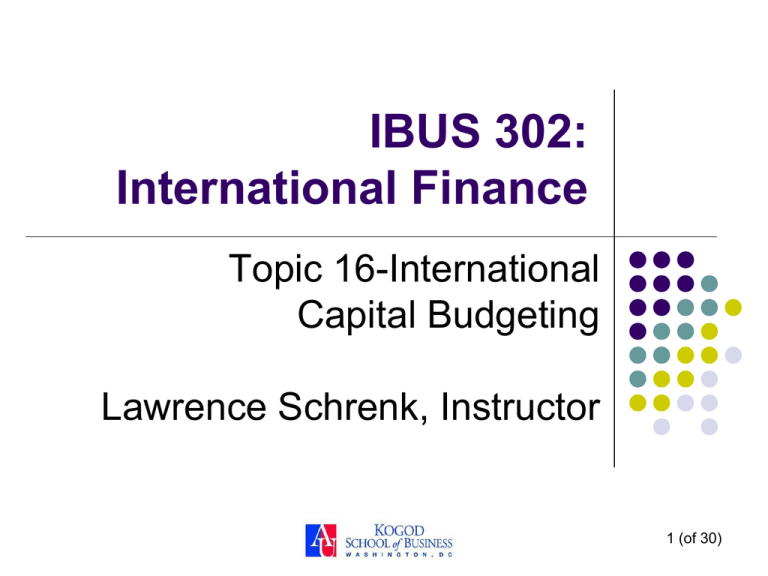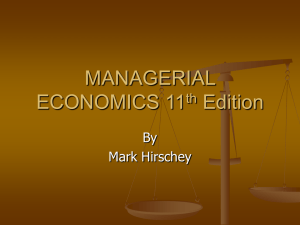PowerPoint Slides 19
advertisement

IBUS 302: International Finance Topic 16-International Capital Budgeting Lawrence Schrenk, Instructor 1 (of 30) Learning Objectives 1. 2. 3. 4. Explain the process of capital budgeting▪ Discuss how the process changes in an international environment. Calculate a cross-border NPV from the parent firm’s perspective. Describe some uses of real options in capital budgeting.▪ 2 (of 30) Domestic Capital Budgeting 3 (of 30) NPV NPV is the present value of future cash flows minus the initial net cash outlay for the project discounted at the project’s cost of capital. Assuming the goal of maximizing shareholder wealth, any project with a positive NPV should be pursued. Generally, the source of financing is irrelevant to the investment decision. 4 (of 30) NPV Advantages Evaluates investment in the same manner as a company’s shareholders. Focuses in on cash and not accounting profits Emphasizes the opportunity cost of the money invested. 5 (of 30) NPV Difficulties Estimating cash flows. The cost of the project The cash inflows during the life of the project (especially hard where there are relevant spillovers–cannibalization or sales creation) The terminal or ending values of the project. 6 (of 30) “Domestic” NPV Calculations 1. Estimate Future Cash Flows E[CFt] Include only incremental cash flows Include all opportunity costs The algebra of cross-border investment analysis “Domestic” NPV Calculations 2. Identify Risk-Adjusted Discount Rate Discount nominal CFs at nominal discount rates and real CFs at real discount rates Discount equity CFs at equity discount rates and debt CFs at debt discount rates Discount CFs to debt and equity at the WACC Discount cash flows in a particular currency at a discount rate in that currency The algebra of cross-border investment analysis “Domestic” NPV Calculations 3. Calculate net present value NPV Based on expected future cash flows and the appropriate risk-adjusted discount rate The algebra of cross-border investment analysis International Capital Budgeting 10 (of 30) New Issues Which Currency to Use Exchange Rate Risk Does Purchasing Power Parity Hold Foreign & Domestic Tax Rates Cost of Capital Special elements: Political Risk Subsidies 11 (of 28) Two Valuation Methods NPV Traditional NPV analysis extended to int’l projects APV (valuation by parts) APV = PV[OCF] + PV[Project costs & benefits] Project costs & benefits: PV of tax shields PV of financial subsidies 12 (of 28) Net Present Value 13 (of 30) International Capital Budgeting Foreign projects generate cash flows in a foreign currency. Two Approaches Approach 1: Foreign Project Approach 2: Parent Firm 14 (of 30) Approach 1: Project’s (Local) Perspective Estimate cash flows in foreign currency Discount in the foreign currency Find the foreign currency NPV Convert foreign currency NPV to a domestic currency value at the spot exchange rate. The algebra of cross-border investment analysis Approach 2: Parent’s Perspective Estimate cash flows in foreign currency Convert foreign cash flows into the domestic currency at expected future spot rates Discount in the domestic currency Find the domestic NPV The algebra of cross-border investment analysis Approach 1: Discount in the Foreign Currency 1. Estimate future cash flows E[CFtf] 2. Identify discount rate 3. Calculate net present value Calculate NPV Convert to the domestic currency E[CF1f ] NPV0f NPV0d= S0d/f NPV0f The algebra of cross-border investment analysis E[CF2f ] if Approach 2: Discount in the Domestic Currency 1. Estimate E[CFtd] = E[Std/f ] E[CFtf ] 2. Identify discount rate 3. Calculate net present value NPV E[CF1f ] E[CF2f ] E[CFtd ] = E[Std/f ] E[CFtf ] NPV0 The algebra of cross-border investment analysis Two Approaches You should have two equally valid approaches: Change the foreign cash flows into dollars at the exchange rates expected to prevail. Find the $NPV using the dollar cost of capital. Find the foreign currency NPV using the foreign currency cost of capital. Translate that into dollars at the spot exchange rate. 19 (of 30) PPP PPP must hold. Over the life of the project Differential Inflation FX rates must change to compensate 20 (of 28) WACC If PPP holds: 1 W ACC$ 1 W ACCx 1 $ 1 x 21 (of 28) Approach 2: Simple Example U.S. parent considers building a Swiss factory (millions) Initial cost: S($/SF): $50 .50 Projected SF cash flows Year 1: Years 2-5: Year 5 10 SF net revenues revenue growth @ 2% 100 SF Salvage/Terminal Value of Factory Approach 2: Simple Example Exchange rate forecast: Swiss inflation forecast: U.S. inflation forecast: Predicted SF appreciation: PPP 2%/year 3%/year 1%/year NPV Calculation Year 0 Cash Flows ($) ($50.00) 1 2 3 4 5 Cash Flows (SF) S($/SF) Cash Flows ($) PV(Cash Flows $) NPV 24 (of 30) NPV Calculation Year 0 Cash Flows ($) ($50.00) Cash Flows (SF) 1 2 3 SFr. 10.00 SFr. 10.20 SFr. 10.40 4 5 SFr. 10.61 SFr. 110.82 S($/SF) Cash Flows ($) PV(Cash Flows $) NPV 25 (of 30) NPV Calculation Year 0 Cash Flows ($) ($50.00) Cash Flows (SF) S($/SF) 1 2 3 SFr. 10.00 SFr. 10.20 SFr. 10.40 $0.5000 $0.5050 $0.5101 $0.5152 4 5 SFr. 10.61 SFr. 110.82 $0.5203 $0.5255 Cash Flows ($) PV(Cash Flows $) NPV 26 (of 30) NPV Calculation Year 0 Cash Flows ($) ($50.00) Cash Flows (SF) 1 2 3 SFr. 10.00 SFr. 10.20 SFr. 10.40 4 5 SFr. 10.61 SFr. 110.82 S($/SF) $0.5000 $0.5050 $0.5101 $0.5152 $0.5203 $0.5255 Cash Flows ($) PV(Cash Flows $) ($50.00) $5.05 $5.20 $5.36 $5.52 $58.24 NPV 27 (of 30) NPV Calculation Year 0 Cash Flows ($) ($50.00) Cash Flows (SF) 1 2 3 SFr. 10.00 SFr. 10.20 SFr. 10.40 4 5 SFr. 10.61 SFr. 110.82 S($/SF) $0.5000 $0.5050 $0.5101 $0.5152 $0.5203 $0.5255 Cash Flows ($) PV(Cash Flows $) ($50.00) $5.05 $5.20 $5.36 $5.52 $58.24 ($50.00) $4.59 $4.30 $4.03 $3.77 $36.16 NPV 28 (of 30) NPV Calculation Year 0 Cash Flows ($) ($50.00) Cash Flows (SF) 1 2 3 SFr. 10.00 SFr. 10.20 SFr. 10.40 4 5 SFr. 10.61 SFr. 110.82 S($/SF) $0.5000 $0.5050 $0.5101 $0.5152 $0.5203 $0.5255 Cash Flows ($) PV(Cash Flows $) ($50.00) $5.05 $5.20 $5.36 $5.52 $58.24 ($50.00) $4.59 $4.30 $4.03 $3.77 $36.16 NPV $2.85 29 (of 30) Political Risk Adjustment Political Risk Clearly risk and return are correlated. Political risk may exist along side of business risk, necessitating an adjustment in the discount rate. 30 (of 30) Sensitivity Analysis In the APV model, each cash flow has a probability distribution associated with it. Hence, the realized value may be different from what was expected. In sensitivity analysis, different estimates are used for expected inflation rates, cost and pricing estimates, and other inputs for the APV to give the manager a more complete picture of the planned capital investment. Real Options The application of options pricing theory to the evaluation of investment options in real projects is known as real options. A timing option is an option on when to make the investment. A growth option is an option to increase the scale of the investment. A suspension option is an option to temporarily cease production. An abandonment option is an option to quit the investment early.








